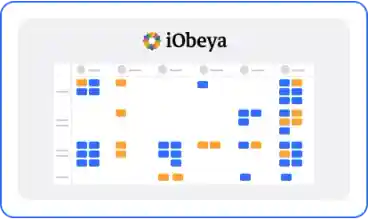Why iObeya
Featured

Efficient work order management is critical to ensuring smooth operations and on-time delivery. However, maintaining real-time visibility of work orders across various teams and departments can be challenging, especially if updates are managed manually. The lack of up-to-date information not only delays responses but also increases the risk of errors and miscommunication.
iObeya offers a solution by providing a centralized, interactive workspace for teams to track and manage processes visually. Many organizations use SAP, a widely adopted enterprise resource planning (ERP) software, to handle work orders and production schedules. Integrating SAP with iObeya can automate the visualization of work orders, allowing teams to track updates in real-time without manual interventions. This article explores how the SAP-iObeya integration transforms work order management, streamlining processes and enhancing operational efficiency.
Before integrating SAP with iObeya, the organization faced several operational challenges:
To keep production work orders updated on digital visual boards, team members had to manually transfer data from SAP ERP to iObeya. This repetitive and non-automated process was labor-intensive, error-prone, and slowed down workflow efficiency.
Due to manual processes, there was often a delay in updating manufacturing work order status on visual management boards . The absence of real-time updates limited proactive decision-making , increasing the risk of missed deadlines and reduced operational efficiency.
Without automated data transfer, the likelihood of data entry errors during SAP-iObeya synchronization was high. Critical work orders in manufacturing planning could be overlooked or inaccurately displayed, causing delays and reducing accountability.
These challenges underscored the need for a streamlined, automated solution that could update work orders in real-time, providing teams with immediate visibility into work order statuses.
To address these challenges, the organization implemented a custom integration between SAP and iObeya. This automated solution eliminated the need for manual updates, creating a smooth, real-time flow of information. Here’s how the integration process works, based on the following schema:
The integration begins with work orders generated in SAP, often based on data from a Manufacturing Execution System (MES). This system collects and organizes data from the production floor, which is then transferred to SAP as work orders.
A daily automated extraction process pulls work order data from SAP in a CSV file format. This automation eliminates the need for manual data extraction, ensuring that all relevant data is captured accurately and consistently.
The extracted CSV data is then processed through a custom script, which formats the data and prepares it for seamless integration into iObeya. This script allows for customization of data fields, ensuring only the necessary information is transferred.
Finally, the processed data is integrated directly into iObeya, updating the work order boards automatically. Teams now have access to real-time work order visualizations, with status updates reflecting any changes made in SAP without manual intervention.
This integration was achieved with contributions from multiple stakeholders:
The integration of SAP with iObeya brought significant benefits, transforming work order visualization and management for the organization:

With real-time updates in iObeya , teams can anticipate upcoming work orders and prepare manufacturing resources accordingly. The automated SAP data flow provides accurate visibility into work order statuses, reducing bottlenecks and preventing last-minute production delays.
By automating data transfers between SAP and iObeya, the integration saves time and reduces repetitive manual data entry. This frees employees to focus on value-added tasks such as Lean process improvement and strategic planning.
Automation reduces the risk of errors and ensures that all work order updates are accurate. This increased accuracy improves accountability and enhances trust in the system.
The seamless automation of the work order visualization process creates a streamlined experience for users. With no need for manual intervention, users can rely on iObeya to display the latest information accurately, improving their overall satisfaction with the platform.
The organization took a structured approach to ensure a smooth implementation of the SAP-iObeya integration:
Management identified the key goals and defined requirements, ensuring that the integration would address the unique needs of the organization.
Working with an external partner, the team developed a custom script to process and transfer data from SAP to iObeya in an automated manner.
The integration was rigorously tested to ensure accuracy, speed, and stability. This step helped resolve any potential issues before full implementation.
After successful testing, the integration went live within two weeks. The organization continues to monitor the integration to ensure that it performs reliably over time.
The integration of SAP with iObeya for automated work order visualization has transformed the organization’s operations. By automating data transfer, the organization eliminated manual processes, minimized errors, and ensured real-time visibility of work orders . Teams now have the tools to anticipate tasks more effectively, improving their overall productivity and ability to meet deadlines.
For any organization facing similar challenges with manual work order updates, integrating SAP with iObeya can significantly enhance operational efficiency and reduce overhead. The automation of work order visualization is not just a time-saver but a step toward a more digital, proactive, and agile approach to managing complex workflows.
If you’re interested in exploring how iObeya’s integration capabilities can streamline your organization’s processes, visit interations or contact the team at contact page. Unlock the potential of visual management with customized, automated integrations tailored to your unique business needs.